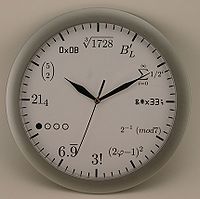Lecture 4
Readings For This Lecture
Keshet Course Notes:
- Chapter 2, Pages 33 to 42
Summary
1. Reviewed the solution to question 10 in [Lecture 2].
2. Riemann Sums
- Example 1: Find the area of f(x) = 2-x. Interval: 0 to 2
- 2 methods to do this:
- A) Using

- B) Using the right end points for rectangle height:




![{\displaystyle {\frac {2i}{N}}]}](https://wiki.ubc.ca/api/rest_v1/media/math/render/svg/f2e52c3173089a100d86102b8099c3439798b73b)
- Using the midpoints points for rectangle height:





![{\displaystyle {\frac {1}{N}})]}](https://wiki.ubc.ca/api/rest_v1/media/math/render/svg/6679ed59d57b6e69cde925102cbe52bc07b696a7)
- which is equivalent to:





![{\displaystyle {\frac {1}{N}})]}](https://wiki.ubc.ca/api/rest_v1/media/math/render/svg/6679ed59d57b6e69cde925102cbe52bc07b696a7)
- Using the left end points for rectangle height:




![{\displaystyle {\frac {2(i-1)}{N}}]}](https://wiki.ubc.ca/api/rest_v1/media/math/render/svg/3419a0f4b7820819e85b852f907cb6e90015bcde)
- which is equivalent to:




![{\displaystyle {\frac {2i}{N}}]}](https://wiki.ubc.ca/api/rest_v1/media/math/render/svg/f2e52c3173089a100d86102b8099c3439798b73b)
- We continue with the following and proceed to evaluate the answer:



![{\displaystyle {\frac {2i}{N}}]}](https://wiki.ubc.ca/api/rest_v1/media/math/render/svg/f2e52c3173089a100d86102b8099c3439798b73b)




![{\displaystyle \sum _{i=1}^{N}i]}](https://wiki.ubc.ca/api/rest_v1/media/math/render/svg/0886abc8565eaa8d5b1670be351645f336728f6e)








- Example 2:
Exercises
1. Find the area between the two functions  and
and  . You should solve this problem by setting it up as a sum of rectangular strips.
. You should solve this problem by setting it up as a sum of rectangular strips.
2. Determine the function  and the interval on the
and the interval on the  -axis such that the expression below is equal to the area under the graph of
-axis such that the expression below is equal to the area under the graph of  over the given interval:
over the given interval:
 .
.
3. Use Riemann sums to find an expression for the area under the graph of
 .
.
4. Use geometric arguments to compute the area of
 .
.
5. Use geometric arguments to compute the area of
 .
.
6. Consider the shape of a symmetric (about the  -axis) leaf, given by the function
-axis) leaf, given by the function  . Given this choice of function for the top edge of the leaf, we know the leaf has length 1. Find the width of the leaf (the distance between the top and bottom edge at its widest point). Find the area of this leaf by dissecting the shape into rectangles.
. Given this choice of function for the top edge of the leaf, we know the leaf has length 1. Find the width of the leaf (the distance between the top and bottom edge at its widest point). Find the area of this leaf by dissecting the shape into rectangles.






![{\displaystyle {\frac {2i}{N}}]}](https://wiki.ubc.ca/api/rest_v1/media/math/render/svg/f2e52c3173089a100d86102b8099c3439798b73b)


![{\displaystyle {\frac {1}{N}})]}](https://wiki.ubc.ca/api/rest_v1/media/math/render/svg/6679ed59d57b6e69cde925102cbe52bc07b696a7)


![{\displaystyle {\frac {2(i-1)}{N}}]}](https://wiki.ubc.ca/api/rest_v1/media/math/render/svg/3419a0f4b7820819e85b852f907cb6e90015bcde)





![{\displaystyle \sum _{i=1}^{N}i]}](https://wiki.ubc.ca/api/rest_v1/media/math/render/svg/0886abc8565eaa8d5b1670be351645f336728f6e)
















